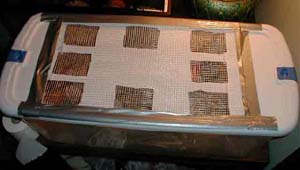| Beginner:
Sterilite bin cage
Buy
a larger Sterlite bin which are available as most department
stores and home centers. Either replace the lid totally with
a large piece of hardware mesh folded down over the edges, or
do what is shown in the photo: cut out large areas of the lid
leaving the edges intact to use as a frame and be sure to seal
the edges of the mesh so a mouse can't slip out.
Total
cost for this large cage: $12
 
Advanced:
Wood framed cage with Plexiglas sides
This one
was built from a 3' x 6' sheet of plywood, 2x2 lumber, and large
sheets of Plexiglas. Build the frame to the dimensions of the
cage you want and cut the plywood to the same size. Fasten the
wood together at all the corners with good long wood screws.
Cut the Plexiglas to size (this plexi was cut with a special
circular saw blade) and attach using Liquid Nails or other plexiglas-compatible
construction adhesive. The lid is simply a wood 2x2 frame made
just slightly larger than the cage. The frame is covered in
a roll of 1/4" 3' wide hardware mesh and stapled all around
the edges. Be sure to cover the floor with a cut-to-fit piece
of vinyl flooring (Linoleum) so the urine can't soak into the
wood. Use caution if you decide to seal or stain your cage since
the mice will gnaw and some sealers/paints are toxic. The example
shown has not been sealed at all.
 

[
Back to Top | Return
to Rodent Central Home ]
|